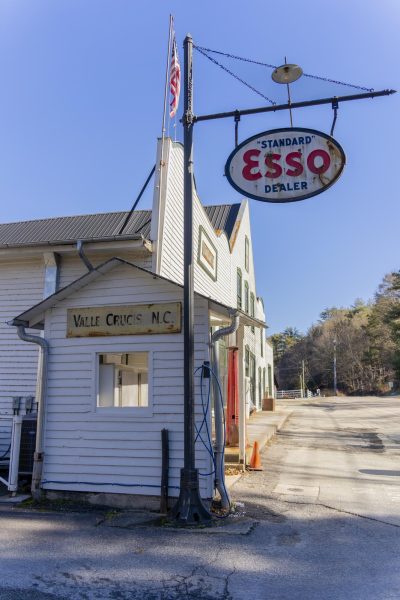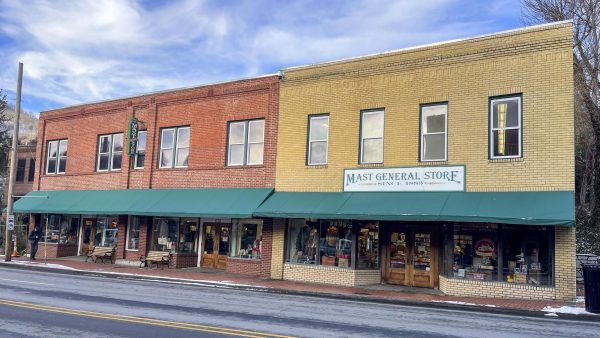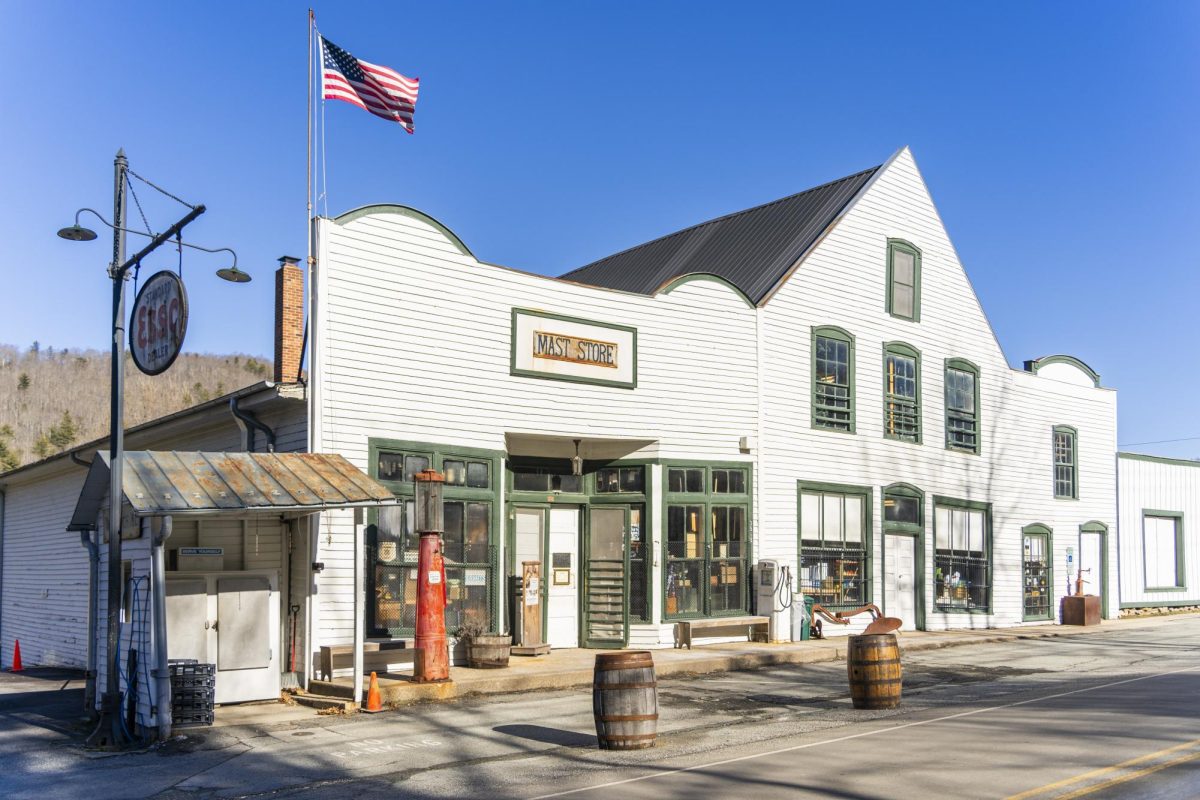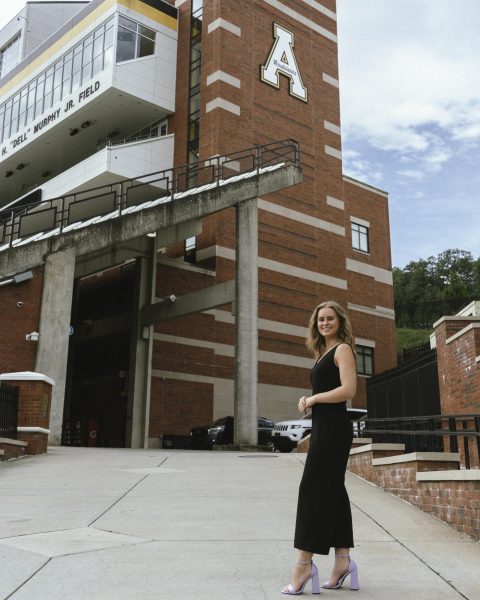In the heart of downtown Boone, surrounded by the hustle and bustle of a booming college town, is the Mast General Store. The store is a landmark mercantile known for its barrels of candy and the plethora of outdoor gear sold for those in Boone wanting to get outside and enjoy the beauty of the mountains we call home.
Unknown to some visitors of the King Street store is the company’s deep roots in Watauga County with over 100 years of community, service and support.
In its early days, the store served as a location for the residents of Valle Crucis to trade spices or crops for items they needed, said Sheri Moretz, the storyteller for the Mast General Store.
In a mountain valley surrounded by creeks, forests and rolling fields, Bishop Levi Silliman Ives saw the shape of the Saint Andrew’s Cross in the valley and decided to call the area Valle Crucis, or “the Valley of the Cross.”
“We have ledgers that date from 1861 from the Taylor and Moore store,” Moretz said.
She said the store carried everything from farming equipment, stove parts, harnesses and farm outfitting. They also carried collars, clothing and shoes, as well as things to make life a little sweeter, like coffee and candy.
As more and more community members began to utilize the store, the store’s owner, Henry Taylor, needed more space to expand the inventory of the store to include more of what the townspeople needed. He started expanding by adding 20 feet to the front of the store, which served as one of Watauga County’s first doctors offices, Moretz said.
As the years went on and business was booming, the store became more than just a place to buy and trade goods; people flocked to the store to share news and make announcements. Taylor would head down the mountain to Elk Park to pick up goods to sell at the store. On these trips, he picked up newspapers from the nearby larger cities in Tennessee, like Johnson City and Knoxville.
“As a general store, it was definitely, in earlier times, a link to the outside world,” Moretz said. “The store became a community center. People would come in and announce news or new babies and spread word about people who needed help. It was a hub of communication and a place to give back to the community.”
In 1897, Henry Taylor sold half of the store to one William Wellington Mast, and the store became known as the Taylor and Mast General Store. With a fully functioning post office and a huge potbelly stove, members of the Valle Crucis community continued to travel to the store and more goods could be found on the shelves. Taylor and Mast coined the old slogan for the store: “If you can’t buy it here, you don’t need it.”
In 1913, W.W. Mast bought out the remainder of shares in the store, and it became known simply as the Mast General Store. With a robust tourism industry, Valle Crucis relied on the store for not only personal needs, but also as a way to continue to bring visitors up from off the mountain, Moretz said.
Tourism began in the Valle Crucis area as early as the late 1800s.
“The bigger homes out here, just down the road from the store, were all boarding houses. People from Charlotte and farther off would come stay for months at a time,” Moretz said. “According to a 1927 flier, people came to Valle Crucis for the same things that bring people to the area today – horseback riding, hiking, Grandfather Mountain.”
In the 1930s, as App State was filling with students, Mast General was still serving as a tourist hotspot. During this time, W.W. Mast made a business deal with Standard Oil, known now as Exxon, and began selling gas at the store.

“Mast was the longest running dealer for Standard Oil. We have receipts dating back to the early 1900s. Those coming off the mountain needed somewhere to fill their cars to come back home,” Moretz said.
Erin Welsh worked as an area manager at the Mast General Store from 2011 until 2018 and is a longtime resident of Valle Crucis. She said that during the big flood of 1940, people turned to the store for shelter and a place to gather and mourn the losses the community faced in the wake of the disaster.
“The store was also a gathering space for the tough times. Legend says that after the flood, they stored some of the bodies of the deceased on the third floor because it was such a central space,” Welsh said.
The store remained in the Mast family until the 1970s, when it went through several ownership changes. By 1977, the store was co-owned by a doctor from Atlanta and a professor at App State, Moretz said.
In the fall of 1977, the store was closed for the winter in the hopes of reopening in the spring when the harshest parts of winter had passed. Unfortunately, the store never reopened.
“The store was closed for a very short period of time, maybe a year, but during that time, Valle Crucis lost a lot of its identity. It lost its post office, which has further implications of losing its community,” Welsh said.
In 1979, a young family from Florida caught wind of the store’s closure and decided to purchase the store and move to Valle Crucis. This family was the Cooper family.
John and Faye Cooper moved their little family to the third floor of the store and began the process of reopening.
The store closed because winters didn’t bring in many visitors, with the rationale to close and reopen in spring when more people would be visiting. When the store didn’t reopen, the Cooper’s purchased the store in 1979 and then moved into the store in 1980.
“They came in in April 1980, rolled up their sleeves, and opened June 6th, 1980,” Moretz said.
The first order of business for the Coopers was to reopen the post office for members of the community to use once again. With much success, the post office became fully functional and the town had restored its identity and preserved its place on the map.
“The store was very much owner-operated. Faye even ran a sandwich counter in the back of the store and people loved it. She made all the sandwiches herself,” Welsh said.
A few years later, the Coopers purchased the Annex store two-tenths of a mile down the road from the original store, and Mast General only continued to grow from there.
In 1973, the store was added to the National Registry of Historic Places as one of the best remaining examples of an old southern general store.
John Pickett visited the store for the first time as an adult on a trip to North Carolina in the fall of 2023. He said it was cool to see such a preserved piece of history.
“I grew up in North Carolina and always visited the store as a kid, but I never made it out here to see it after I left for college 30 years ago,” Pickett said. “When I stepped into the store, it felt like I was stepping back in time. After visiting and hearing about the lasting impact the store has had on this community for so long, it is clear to me how important it is to preserve places like Mast for the communities that need them.”
With 11 branches of the store scattered throughout the Southeast, Mast continues to serve as a community gathering place for several towns and cities.

“In the roots of Mast being part of the community, we continue that today by encouraging employees to be part of the community and give back to funds that matter to them,” Moretz said. “We donate a lot of food to the community, we support preservation and conservation through land trusts, and we support arts and education, things that are community forward.”
To this day, the original store is a beacon of community for Valle Crucis. Welsh said during her time working at the store, she was able to connect with her neighbors in a way she wouldn’t have been able to without the store.
“Even today, because the Cooper’s brought the post office back, there is a real community feel that you don’t see in a typical retail store,” she said. “When I leave for work, I can recognize a lot of the cars that are pulling in to check their mail. The store is central to who we are as a community.”




Charles Skinner • Jan 23, 2024 at 11:23 am
Thank you for this article on the Mast General Store. I did my student teaching at the Valle Crisis Elementary school in 1976 and could see the store across the field when looking out the classroom window. I remember on Saturday nights the community would gather with some bringing instruments and there was beautiful singing. Once while on the second floor of the store while playing a dulcimer I had my picture taken by a photographer from the Charlotte Observer.
Todd Woods • Jan 18, 2024 at 8:01 am
I don’t believe John and Faye Cooper still own Mast. Is that the case and, if so, why is their exit not part of this article?